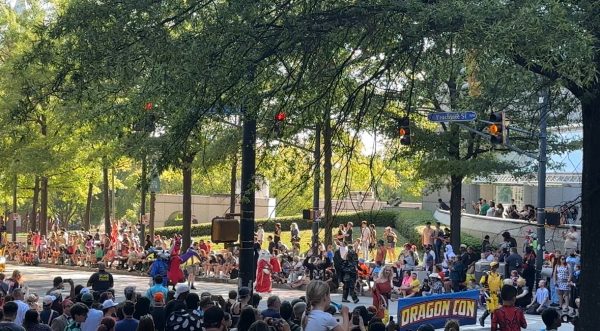What the…?
Artist takes unusual art form public
Bright yellow animal-crossing signs lined Decatur streets last September. These professionally-made signs featured animals ranging from octopi to kiwi, giraffes to crabs.
The animals will decorate Decatur light posts indefinitely because of the city’s love for them.
Sophomore Simon Ray first noticed the art during the 2014 Decatur Book Festival. Ray took photos of the signs each time he noticed a new one.
“When I saw them, I kind of had a double-take moment,” Ray said. “They were just so bizarre.”
Ray originally thought the signs were a part of the book festival’s display. After the festival ended, he realized they were much more than that.
“It’s just never something I’ve seen Decatur do before,” Ray said.
Decatur resident Larry Holland is the mastermind behind these unique creations. He proposed a “Pop-Up Art Installment” plan to the city of Decatur in the fall of 2014.

The proposal to the city was simple. Holland wrote up his idea to create street signs after collaborating with Decatur Arts Alliance members. He needed permission to hang the signs on the light posts. After the city approved his project, Holland got to work.
He installed all the signs in the middle of the night to surprise Decatur residents. He purchased Department of Transportation signs from a pawn shop, then worked with Gerry Gorman, a graphic designer, to choose animals and create “high-quality outdoor stickers.”
The two met three years ago at Free Art Friday, an Atlanta art scavenger hunt.
Holland contacted Gorman to explain the art installment. Gorman agreed to help. Holland chose the animals, and Gorman created the silhouettes through a computer program. As the artist, Holland approved the designs and placed the animals on the signs.
“Larry brings up a lot of ideas and a lot of projects, then he’ll do what they call an artist call,” Gorman said. “He’ll send an email out and say, ‘Hey guys, [I’m] working on a project. Is anybody interested?’ A lot of times, I usually jump up for it.”
Gorman believes public art can be described as anything that “brings character to the city.” Though Gorman only works in Decatur, he noticed how receptive residents were to the signs.
“What I enjoyed most [was] the reaction of the community,” Gorman said. “Some people seriously got mad, and some people were like, ‘Oh, this is genius.’”
Holland also appreciated most responses he received, aside from his art being stolen.
“I put up 29 [signs],” he said. “So far, two have disappeared.”
Holland thinks the Pop-Up installments allow Decaturites to adjust to the idea of public art. Angie Macon, Decatur Arts Allance executive director, agreed.
“We are trying to make more public art a part of Decatur,” Macon said.
With the growth of public art in Decatur, the city has collected enough art to have “one of the largest public art exhibitions.”
The Decatur Arts Alliance presented a seed, or small, grant to four Decatur artists, including Holland. His second installment, “fairy doors,” was funded by the seed grant.
These miniature doors, often seen in fairy tales, are the second part of the Pop-Up Art installment. In fairy tales, these mystical portals transport characters to lands of magic and adventure.
The three other grant recipients are creating works ranging from a one-woman play to an art exhibit in a store window.
“The purpose of the seed grant was not to be confined to one medium,” Macon said.
Mary Pousner, one of the grant recipients, is creating a projection project about raptors, birds of prey, in Decatur. Pousner usually works with “traditional” two-dimensional media, so this project is novel to her art resumé.
“Public art allows the viewer to encounter a fresh experience without going out of their normal routine, creating an opportunity for inspiration or thinking outside the box,” she said.
George Lundeen’s bronze sculpture, Valentine, in downtown Decatur is permanent, while Holland’s work is temporary.
“Public art does not always have to be a statue,” Macon said.
Temporary art projects, like Holland’s, help determine which permanent art projects are installed. The artists and the city have to consider material, location and size for outdoor pieces to generate good feedback from residents.
The Pop-Up Art installment proposal is only the beginning of more city approved art projects taking place in Decatur.
“In the long term, we are going to acquire more long term public art that will be placed all over the city, but that requires a big long term investment,” Macon said.
To invest in Decatur’s public art future, the Arts Alliance launched Young Emerging Artists (YEA). YEA encourages students K-12 to gather their work to sell and show off.
Art programs in Decatur, like YEA, promote art creation and displays in Decatur. With the continuation of such programs, Decatur residents can start seeing the evolution of art.
Holland released his fairy doors in March 2015. Again, he hung the art overnight to surprise residents.
In addition to the signs, Decaturites can enjoy Holland’s new display: miniature doors in every color and style, decorated by various artists, bringing life to walls of Decatur buildings.










